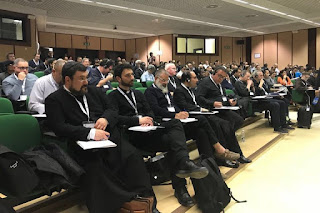Ireland is not immune to the draw of controversial Indian guru Bhagwan Shree Rajneesh. John Meagher speaks to Irish devotees of the flamboyant spiritual leader who owned a fleet of Rolls-Royces, tried to build a city in Oregon and is the subject of a major TV documentary.
Irish Independent News
April 15 2018
It was March 18, 1986 and RTÉ's cameras were among the journalists and curious onlookers outside Jurys Hotel, Limerick, to witness the departure of a mysterious guest. The Indian guru, Bhagwan Shree Rajneesh, had been holed up in the hotel for the previous 11 days - he and his eight-strong entourage had booked out an entire floor - and now he was departing.
The mystic with the ankle-length white robe and the flowing grey beard cut a serene figure as the journalists swooped in with their microphones. He put the palms of his hands together as if in prayer and gave short, polite and bland answers to their questions.
The 54-year-old was a source of considerable intrigue at the time. His followers - the orange and maroon-clad Rajneeshees, or Sannyasins as they were often known - had created a veritable city in the Oregon wilderness that had outraged conservative America and troubled those who worried that it was another cult in the same vein as the one Jim Jones had led in Guyana and resulted in the mass suicide of 918 people in 1978.
And the Rajneeshees had spectacularly fallen out with local residents. De facto leader of the giant commune, Ma Anand Sheela - who was also Bhagwan's personal secretary - was given a 20-year jail sentence for such crimes as deliberately food poisoning a large chunk of the population in order to skew election results in Wasco County and for plotting to assassinate US federal prosecutor Charles Turner.
Bhagwan, himself, was forced to flee the US. He was subsequently expelled from Greece and was refused access to Britain. He wound up in Ireland after his plane had stopped to refuel at Shannon airport and he was granted a short-stay visa. American authorities had sought his expulsion but Taoiseach Garret FitzGerald would not accede to their pleas.
But it appears that Bhagwan - who had a vast fleet of Rolls-Royce cars, a private jet and enjoyed other trappings of unimaginable luxury - simply tired of Ireland and of a hotel that he didn't stir from once, and he couldn't wait to fly out to warmer climes. He eventually ended up back in Pune, in India, where his ashram - spiritual monastery - is still going strong more than 30 years later.
Bhagwan Shree Rajneesh - or Osho, as he later wished to be called - died in 1990 and memory of the controversy surrounding his followers faded. But an absorbing new Netflix six-part documentary, Wild Wild Country, shines a light on this most contentious of figures and of the anything-goes commune-city, Rajneeshpuram, that existed in Oregon between 1981 and 1985.
Fact stranger than fiction
Several of those who played key roles in the organisation are interviewed in the documentary, including Sheela, who served just 29 months of her sentence. It's a story that truly lives up to the fact-being-stranger-than-fiction cliché.
Jacques Piraprez Nutan, a Belgium-born Irish citizen, lives in Kinvara, Co Galway, and turned 70 a fortnight ago. He remains an Osho devotee.
"His teachings changed my life forever when I was first exposed to them in the early 1970s," he says, "and my life has been so much better than it might have been thanks to him."
Nutan - a professional photographer since the late 1960s - had been working as an art college lecturer in Dublin when he was first introduced to Bhagwan by a tarot card reader. "It completely opened my eyes," he says. "It was an awakening for me when I realised that you really could follow a different way of life where you could shake off the limitations of the every day and really get to know yourself.
"It's very hard for me to describe it, but when you learn to meditate like that it stays with you for life. It's like one day you can't ride a bike, and then one day you can and that never changes."
He moved to India shortly after reading the Bhagwan's book The Silent Explosion and found that he got plenty of access to the guru. "I worked as a photographer for him for some time," he says. "There was something very special about him - he had a presence that was unlike anyone else I ever met."
Nutan enjoyed life at the ashram and fully embraced Bhagwan's unusual teachings, including dynamic mediation - which features, arrestingly, in Wild Wild Country and is as much about making rapid movement and primal sounds as it is about silence.
After eight years, he left India and returned to Ireland. "I felt a sense of bliss when I was at the ashram and it never left me," he insists. "Many of his teachings were focused on the modern mind and self-improvement in the course of your normal work. It's something that I cherish every day and I feel better for it."
Nutan is aware that the Netflix series may give viewers a very negative perception on Bhagwan and the Rajneeshees, but he hopes that people will sense that much good has come of it, too. "People ask about his wealth, but I don't care," he says. "It's just a distraction.
"But Sheela," he adds. "I couldn't stand her when I knew her in Pune and she was a very difficult person to get on with." It was, he adds, her way or no way.
Nutan puts Review in touch with a Dublin man, who did not wish to use his Irish name but wished to go by his Indian name, Gopal.
Gopal bristles at the word 'cult'. "That's people from the outside who don't know what they're talking about," he says. "How would I define it? It's mystical and spiritual, but it's not a religion."
Like Nutan, he became interested in Bhagwan in the early 1970s. "The Ireland of the time was a very repressive place. There seemed to be no therapists then, nobody talking about the mind. There was ignorance, too. So, when I went to India then, it felt like a completely different world." Gopal talks about recalibrating, rethinking everything he had known in life. His wife and young children moved, too - the family home was sold much to the concern of both sets of parents - but he says they had no regrets. The marriage ended before the move to Oregon.
The 'free love' that was common to Rajneesh disciples at the time put paid to the notion of monogamy. "It's not as much fun as you might imagine being sexually free," Gopal says, drily.
At the time of the Oregon venture, Rajneesh devotees were being talked of in the media as a "sex cult" and Wild Wild Country certainly gives the sense that promiscuity was the order of the day. But the Dubliner says Bhagwan did not consider sex as something to be repressed as is so common in mainstream religion.
He points Review to a Rolling Stone interview with one of the documentary's participants, Sunny Massad, and says his quote on the guru and sex is significant.
"When you watch the hundreds of lectures that Osho gave, sex plays a very small part," according to Massad. "His main message about that was that repressing sex does not make you a more spiritual person, as is so often depicted in traditional religions."
But questions remain over whether such an open attitude to sex broke the law. In his book, My Life in Orange, Tim Guest - who had been raised in Sannyasin communes in England and India - wrote about how very young children were used in sexual initiations for older men and how lonely children often resorted to a promiscuous sexuality later in life.
Guest, who died in 2010 aged 34, won widespread critical acclaim for a memoir that suggested that for some children at least, their parents' quest for enlightenment was nothing short of misery for them.
Factor in some of Bhagwan's outrageous views on euthanasia for disabled children - "the child should be put to eternal sleep" - and genetic selection, and it's easy to understand why his pronouncements remain repulsive for some.
And yet, it's hard to deny that for many people around the world, the guru's legacy lives on indelibly in their lives. Helen Quinn came to Osho long after he had died - or as his followers put it, "left his body". A friend had introduced her to a breathing technique he had pioneered and it led her on a journey to uncover more of his work. She says the experience was transformative.
"I had been on anti-depressant medication," she says. "But when I found Osho and his meditations, I didn't need drugs any more." Last year, Quinn - who uses the name Anand, meaning 'bliss' - established Osho Ireland and she regularly leads dynamic mediation sessions from a hall rented in Dublin city centre.
She says she would like to follow such a mediation at home, but as stages two and three of the five-part session require participants to shout freely and recite "Hoo!" while jumping on the spot, she admits it is not easy to practice when living in close proximity to neighbours.
The mediation is rigorous and she says that when she undertook it for 21 consecutive days at the Pune ashram two years ago, she dropped a dress size without changing her diet.
Quinn has found Wild Wild Country to be "eye-opening" and while agreeing that much of what is reported is disturbing, "people may see just how positive Osho's message is for many".
Already, since it was first shown on Netflix, she has noticed an increase in the numbers of people coming to the mediation sessions or simply making enquiries. "There's a curiosity out there," she adds, "and it might encourage people to ask the big questions of themselves - 'what am I doing here?' and 'can I live a more fulfilling life'?"
She believes that it is not necessary to live in a commune or spend months at an ashram in order to live a better, more centred life. "It's taking it into the every day that's important," she says. And she believes she has managed to adhere to some of Osho's teachings while also pursuing the demanding profession of being a business advisory consultant.
Bhagwan Shree Rajneesh was born in a small village in the former British India in 1931. He spent his formative years being brought up by his grandparents and he attributed much of his future philosophies to his grandmother, who allowed him to enjoy an early childhood free of boundaries.
Freer acceptance of sex
He was admired for a searing intellect while at university at Jabalpur - first as a student and later as a lecturer. Throughout the 1960s, he espoused the idea of individual personal development, and he would shock Hindu leaders when he called for a freer acceptance of sex. His lectures on the subject were later collected in a book, From Sex to Superconsciousness.
His popularity spread outside of India at around the time that another, older guru, Maharishi Mahesh Yogi, was attracting an international following including, famously, the Beatles.
He established his ashram in Pune in 1974 and it continues to attract thousands of 'pilgrims' today even if it is described by Gopal as a sanitised version of what it once was.
Back in 1978, when he and his wife moved permanently from Ireland to the ashram, each had to pay $5,000 for the privilege - the price of a new luxury car at the time.
And Rajneesh certainly liked expensive cars. Estimates vary wildly, but it's thought he owned at least 100 Rolls-Royce vehicles - and when Rajneeshpuram was being constructed, a runway was hewn out of the Oregon mountains to accommodate his private jet.
His ostentatious wealth does not seem to have bothered his followers, and many who met him were besotted by him - none more so than Sheela Silverman, the future Ma Anand Sheela. But Bhagwan would have harsh words for her and her actions when his American dream died.
In 1989, back in Pune, and newly excited by Zen Buddhism, he changed his name to Osho and requested that all Bhagwan logos and merchandise be changed to reflect his new identity. He was ill in the final years of his life and died in January 1990, aged 58.
But Osho lives on, not least in rural Munster where the Dubliner who had lived through the Oregon experience now resides. "He touched so many lives," he says. "I remember going to the hotel that he was in that time in Limerick, and not getting to see him, but being in that building and just feeling his presence there. It was quite extraordinary."
https://www.independent.ie/irish-news/bhagwan-and-me-ireland-not-immune-to-draw-of-controversial-indian-guru-36801779.html









